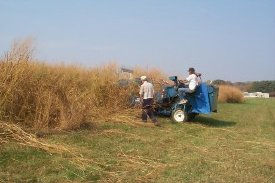Jul 12 2010
While scientists have conducted numerous studies on production of biomass from biofuel crops, such as switchgrass, no one has yet compiled this information to evaluate the response of biomass yield to soils, climate, and crop management across the United States.
A team of researchers from Oak Ridge National Laboratory and Dartmouth College published just such a study in the July-August 2010 Agronomy Journal, published by the American Society of Agronomy. The researchers used peer-reviewed publications to evaluate switchgrass yield as it relates to site location, plot size, stand age, harvest frequency, fertilizer application, climate, and land quality. Switchgrass is one type of crop under consideration for use as a feedstock for advanced biofuels.
 Scientists harvest switchgrass planted at the University of Tennessee, Knoxville. The field trial was established in 1992 by researchers from Virginia Tech to examine biomass production across a five-state region. That study ultimately spanned ten years and compared yield of six cultivars produced under two harvest management regimes.
Scientists harvest switchgrass planted at the University of Tennessee, Knoxville. The field trial was established in 1992 by researchers from Virginia Tech to examine biomass production across a five-state region. That study ultimately spanned ten years and compared yield of six cultivars produced under two harvest management regimes.
The scientists compiled a total of 1,190 biomass yield observations for both lowland and upland types of switchgrass grown from 39 field sites across the United States. Observations were pulled from 18 publications that reported results from field trials in 17 states, from Beeville, TX in the south, to Munich, ND in the Midwest, and Rock Springs, PA in the northeast.
Among the many factors examined, statistical analysis revealed that much of the variation in yield could be accounted for by variation in growing season precipitation, annual temperature, nitrogen fertilization, and they type of switchgrass.
Lowland switchgrass outperformed upland varieties at most locations, except at northern latitudes. Annual yields averaged 12.9 metric tons per hectare for lowland and 8.7 metric tons for upland ecotypes. Some field sites in Alabama, Texas and Oklahoma reported biomass yields greater than 28 metric tons per hectare using the lowland cultivars Kanlow and Alamo.
The research team did not observe any bias for higher yields associated with experimental plot size, row spacing, or with preferential establishment of stands on high quality lands. A model developed from the data, based on long-term climate records, projected maximum yields in a corridor westward from the mid-Atlantic coast to Kansas and Oklahoma. Low precipitation west of the Great Plans limited yields in that region.
“Field trials are often planted to provide local estimates of crop production,” said Stan Wullschleger, a crop physiologist who led the study. “However, viewed in a broader context, results from individual field trials can contribute to a larger perspective and provide regional to national scale estimates of yield and the variables that determine that yield.”
Lee Lynd, co-author on the article and Steering Committee Chair of the Global Sustainable Bioenergy Project observed, “This is the largest data base analyzed to date for energy crop productivity as a function of geographically distributed variables. The finding that there is no bias with respect to either plot size or land productivity is important. A promising future direction is to apply the modeling approaches taken here to additional bioenergy crops at a global scale in combination with various land use scenarios.”
Scientists at Oak Ridge National Laboratory and Dartmouth College continue to explore factors involved in the production of biomass from switchgrass and other dedicated energy crops. One of the lessons learned from the current analysis is that yield data from an even broader range of soil and climatic conditions will be useful in building better predictive models. Future studies should extend the geographic distribution of field trials and thus improve our understanding of biomass production for promising biofuels like switchgrass.
The full article is available for no charge for 30 days following the date of this summary. View the abstract at http://agron.scijournals.org/cgi/content/abstract/102/4/1158.